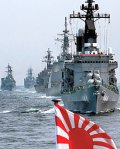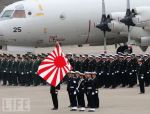Discourage Japanese Military Expansion
This entry is actually a paper I have just submitted as part of a Master of International Relations course. I want to point out that while in the paper I accept rather uncritically that Western influence in Asia is a good or natural state of affairs, this is primarily for the purposes of the argument as opposed to a full expression of my true opinions. However, I do stand by the key idea that expanding Japanese military power raises the probabilities of conflict or instability in Asia, and should be discouraged.
Foreign Policy of Japan Paper
Japanese foreign policy has gradually changed since the Cold War, as Japan’s allies have encouraged it to abandon the Yoshida Doctrine’s institutional pacifism and adopt a pro-active role in maintaining global security. This paper will examine the transition of Japanese foreign policy towards becoming a ‘normal’ state, and consider the questions of whether their quest for a United Nations Security Council seat should be supported, and if Asian nations are justified in emphasising Japanese war crimes in opposition to Japan’s expanding role. I will argue that replacing the Japanese army with an American security treaty helped to maintain Asian stability in the late Twentieth Century, and that most scenarios of expanding Japanese military power indicate an increased likelihood either of regional conflict or decreasing Western influence in the Asia-Pacific. Japan should thus be discouraged from developing its Self-Defense Force beyond minimal requirements. In this context Japan’s membership of the UN Security Council should not be supported, and references to past Japanese atrocities remain relevant and appropriate in discussions of Japan’s international role.
The pacifist Yoshida Doctrine, which advocated the devotion of Japan’s national resources to economic development and an almost total reliance on the United States for defence, dominated Japanese foreign policy thinking throughout the Cold War. Henry Kissinger thought those “Japanese decisions [were] the most farsighted and intelligent of any major nation in the post-World War Two era”.[1] Under the Yoshida Doctrine Japan resisted Western pressure to rearm and instead traded military bases to the US for protection. Japan was thus largely relieved of the burden of maintaining a military, and also benefited economically by supplying American forces in both the Korean and Vietnam Wars.[2] Of course, the historical context of this pacifism was Japan’s destruction in World War Two, following more than half a century of imperialist Japanese foreign policy. Japan had fought wars in East Asia against China in 1894-95 and against Russia in 1905; annexed the Korean Peninsula in 1910, and devoted 70,000 troops to the allied invasion of Russia following the Bolshevik Revolution. They were subsequently the main imperialists in Asia during the 1930s and 40s, invading Manchuria in 1931, and sparking the Second Sino-Japanese War from July 1937 onwards through their continued encroachment into Chinese territory. The aim of conquering Chinese territory and creating a ‘Greater East Asia Co-prosperity Sphere’ led to Japanese military expansion throughout the region, and World War Two in the Pacific.[3]
After the war the United States occupied Japan, and secured their long-term military presence through the 1951 Security Treaty.[4] In these circumstances the sublimation of Japanese energies into economic activity was both appropriate and welcomed by a region who feared them, and a Japan who could be said to fear itself.[5] With this new focus Japan re-emerged as a major economic power in the 1960s, and by the 1990s was the world’s second largest economy.[6] While some analysts have characterised Japan’s subservient foreign policy as ‘karaoke diplomacy’, Richard Samuels argues, “it is not the passivity of karaoke but the defensive nature of the martial art aikido that best characterizes Japanese security policy. … As long as the United States was a credible partner, Japan was smart – indeed strategic – in building a military that could deter but not punish”.[7] While Japan might have seemed like a ‘reactive state’, they also exhibited a ‘pragmatic nationalism’ that advanced Japanese self-interest in the unusual circumstances that existed.[8] This enabled Japan to rebuild from the ruins of war and achieve the highest life expectancy in the world.[9] By the 1980s Japan became a large international investor (of over US$2 trillion by 1991) and a leader in regional development.[10]
While the US had urged Japanese remilitarisation since the late 1960s, it was only after the collapse of the Soviet Union that Japan was forced onto this path.[11] Bhubhindar Singh notes that the Gulf Crisis demonstrated a new element of uncertainty in international affairs which could best be dealt with through multilateral military cooperation.[12] Thus in 1991 Japan was called upon to support the war against Iraq amid an unexpected “storm of international criticism”.[13] In 1992 the UN Peacekeeping Operations Co-operation Bill allowed Japan to deploy troops overseas in limited logistical and humanitarian roles, which they did in Cambodia.[14] This was a shift in Japanese strategic attitudes. Ichiro Ozawa, who oversaw Japan’s political realignment in 1993, “expressed his desired course for Japan to be a ‘normal country’ that pursues its own interests by using all the foreign policy tools that other countries use: economic might, military prowess, and diplomatic skills”.[15] Since then the Self-Defense Force has been authorised to use an increasingly wide range of weaponry in their operations, and public support for Japan’s use of force for defensive purposes has risen.[16] So far Japanese security policy remains triangulated between its still-pacifist constitution, the UN Charter, and the US-Japanese Security Treaty.[17] However, sections of the Japanese media and political establishment increasingly call for Japan to acquire a greater range of defence systems, including long-range fighters, nuclear submarines, a missile defence system, and intelligence-gathering satellites.[18] Self-Defence Force spending is increasing dramatically, and there are calls to amend Article 9 of the constitution, and even to produce nuclear weapons.[19] Eugene Matthews argues that Japan nationalism is rising and, “This development could have an alarming consequence: namely, the rise of a militarized, assertive, and nuclear-armed Japan”.[20]
Japan is slowly shifting its political attitudes and institutional capabilities towards force projection outside of its borders, with the encouragement of the United States. Matthews writes that mainstream Japanese nationalists want, “the respect, political influence, and power commensurate with being the world’s second most important economy and a major contributor to world affairs”.[21] Meanwhile, for America there is less motivation to carry Japan’s defence load, as technology lessens the US Navy’s reliance on Japanese bases – which are themselves high-value targets for enemy nations.[22] Japan’s new strategy involves contributing to the international community responsibly, while being seen as increasingly independent from the United States.[23] Pyle notes that, ironically, the Yoshida Doctrine denied Japan the opportunity to demonstrate its responsibility as a military power.[24]
Most analysts recognise that a more independent Japanese foreign policy will lead to divergences from American policies and goals.[25] Pyle writes that Japanese cooperation, “is not so much the result of shared values as it is of the realist appraisal of the value of the alliance. … Japan will seek maximum autonomy for its own purposes … It will not wish to be hostage to the global strategy of the United States or to its relations with China and Korea”.[26] Inoguichi and Bacon hypothesize that the new relationship might conform to patterns such as the ‘British Model’ of a special relationship, a ‘German Model’ of ‘regional embeddedness’ and institutionalism, or a ‘French Model’ of strong autonomy.[27] But these limited scenarios echo the sentiment of Friedman that, “Conventional political analysis suffers from a profound failure of imagination”.[28] While Japanese political moderates may maintain the current relationship with America, more nationalistic elements could, “shift Japanese doctrine from a tethered, defensive realism to an untethered, offensive realism, in which strategists would be ever alert to exploit opportunities to expand Japan’s power. … It would join the other great powers in a permanent struggle to maximize national strength and influence”.[29] American domination of Japanese foreign policy helped to stabilise Asia during the Cold War. Détente with China, founded on the common Soviet enemy, would have been complicated by an independent Japan; and removing any Japanese threat to Southeast Asia helped to focus their efforts on combating Communist influence. It is possible that a newly independent Japan may either pose a renewed threat to other Asian states, and thus generate instability, or alternatively enhance its relationship with regional powers like China, potentially to the detriment of US regional influence.
Japan’s Self-Defense Force is already considered a powerful regional force, and Japan’s previous decisions not to acquire nuclear weapons have been, “on purely strategic grounds, unrelated to antimilitarism or pacifism”.[30] As Japan has a stockpile of plutonium and extremely sophisticated rocket technology, the possibility remains that Japan could become a major nuclear power within a decade if sufficiently provoked by regional competitors like North Korea.[31] Neo-Realist Kenneth Waltz has argued that Asia’s security environment will eventually compel Japan to nuclearise.[32] China and Japan are each dominant in the others’ strategic thinking regarding economic, political and military issues, and the enhancement of Japanese military power must influence China’s own strategic vision.[33] China and Korea also remain “convinced that Japanese militarism, supported by an invigorated nationalist right wing, lurks just beneath the surface”. [34] At the very least Japan’s new foreign policy could escalate into a regional arms race, with the potential for both Japan and South Korea to nuclearise. Issues like the Senkaku Islands, the division of Korea, and Chinese claims on Taiwan provide continuing fault-lines around which conflict might develop.[35]
China also has the potential for internal instability, as its social and political tensions threaten economic slump and social unrest, perhaps even leading to territorial disintegration. In a situation of political factionalism or civil conflict in China, Japan would be unlikely to remain a neutral onlooker, and might become a ‘king-maker’ on the mainland.[36] Japan’s willingness to influence smaller Asia-Pacific nations, in opposition to Western goals, manifests today in forums dealing with whaling and endangered species protection.[37] Meanwhile, issues of biased histories in Japanese schoolbooks, and visits to the Yasukuni Shrine prompt observers to fear new generations of Japanese may forget the horrors of war, and how easily nationalism may turn into imperialism.[38] On the other hand, hostility between China and Japan is not predestined, and they are two economies that already engage in the largest volume of bilateral trade in history. They are intertwined with investment, production and consumption, and 10 million Chinese work in Japanese firms.[39] In a situation of rising Japanese and Chinese power and cooperation, it is likely that Western influence in Asia could decline, and attempts by the US to retain such influence could lead to resentment and conflict.[40]
While America dominated Japanese foreign policy, hostilities by Japan or alliances forged in opposition to Western interests were precluded. This facilitated détente with China, and pro-Western policies throughout Southeast Asia. Encouraging independence in Japanese foreign policy holds a wide potential for developments inimical to Western interests. As this is the case, expressions of this independence should be limited as much as possible. While the likelihood of Japan attaining a UN Security Council seat is extremely low, and China has already made its opposition clear, the West should oppose the goal in order to limit Japan’s ‘Great Power’ ambitions.[41] And if rising Japanese nationalism can be seen as a threat, then reference to past Japanese war atrocities remains important for discouraging the careless embracing of those ideas by the Japanese public, and maintaining the vigilance of the international community against their repetition. As much as many analysts want to promote Japan’s new foreign policy as the ‘natural’ transition to becoming a ‘normal’ power, I believe that the American decision to encourage this transition is short-sighted and may result in detriment to Western interests.
[1] Pyle, Kenneth. “Restructuring Foreign and Defence policy: Japan”, in Anthony McGrew and Christopher Brook (eds), Asia-Pacific in the New World Order, New York: Routledge, 1998, pp123-124.
[2] Pyle, “Restructuring foreign and defence policy”, pp123-124.
[3] Mackerras, Colin, “From Imperialism to the End of the Cold War”, in Anthony McGrew and Christopher Brook (eds), Asia-Pacific in the New World Order, New York: Routledge, 1998, pp37-38.
[4] Mackerras, “From Imperialism to the End of the Cold War”, p41.
[5] Matthews, Eugene A. “Japan’s New Nationalism”, Foreign Affairs, Vol 82, No 6, Nov-Dec 2003, p76.
[6] Mackerras, “From Imperialism to the End of the Cold War”, p49.
[7] Samuels, Richard J. Securing Japan: Tokyo’s Grand Strategy and the Future of East Asia, Ithaca: Cornell University Press, 2007, p3.
[8] Pyle, “Restructuring foreign and defence policy”, p122.
[9] Mackerras, “From Imperialism to the End of the Cold War”, p53.
[10] Pyle, “Restructuring foreign and defence policy”, p128.
[11] Mackerras, “From Imperialism to the End of the Cold War”, p49.
[12] Singh, Bhubhindar, “Japan’s Security Policy: From a Peace State to an International State”, The Pacific Review, Vol 21, No 3, 2008, pp313-314.
[13] Pyle, “Restructuring foreign and defence policy”, pp126-127.
[14] Pyle, “Restructuring foreign and defence policy”, pp126-127.
[15] Sata, Yoichiro, “Conclusion: Japan in Asia and the Pacific”, in Akitoshi Miyashita and Yichiro Sato (eds), Japanese Foreign Policy in Asia and the Pacific, New York: Palgrave, 2001, p200.
[16] Inoguichi, Takashi and Paul Bacon, “Japan’s Emerging Role as a ‘Global Ordinary Power’”, International Relations of the Asia-Pacific, Vol 6, 2006, pp4-5.
[17] Singh, “Japan’s Security Policy”, p314.
[18] Inoguichi and Bacon, “Japan’s Emerging Role”, pp13-15.
[19] Matthews, “Japan’s New Nationalism”, p76.
[20] Matthews, “Japan’s New Nationalism”, pp74-75.
[21] Matthews, “Japan’s New Nationalism”, p85.
[22] Samuels, Securing Japan, p192.
[23] Singh, “Japan’s Security Policy”, p316.
[24] Pyle, “Restructuring foreign and defence policy”, p130.
[25] Sata, “Conclusion: Japan in Asia and the Pacific”, p198.
[26] Pyle, Kenneth B. Japan Rising: The Resurgence of Japanese Power and Purpose, New York: Public Affairs, 2007, p368.
[27] Inoguichi and Bacon, “Japan’s Emerging Role”, pp4-5.
[28] George Friedman, The Next 100 Years: A Forecast for the 21st Century, New York: Anchor Books, 2009, p3.
[29] Samuels, Securing Japan, p193.
[30] Alexander Bukh, Japan’s National Identity and Foreign Policy: Russia as Japan’s ‘Other’, London: Routledge, 2010, pp7-8.
[31] Matthews, “Japan’s New Nationalism”, p78.
[32] Mirashita, A. “Introduction: A Framework for Analysis”, in Akitoshi Miyashita and Yichiro Sato (eds), Japanese Foreign Policy in Asia and the Pacific, New York: Palgrave, 2001, p5.
[33] Pyle, Japan Rising, pp312-315.
[34] Samuels, Securing Japan, p2.
[35] Matthews, “Japan’s New Nationalism”, p81.
[36] Pyle, Japan Rising, p337.
[37] Sara Phillips, “Japan heading for a sea of isolation”, ABC News (Australia) – Environment, 29 Mar 2010, Accessed 30/03/10 at http://www.abc.net.au/environment/articles/2010/03/29/2858777.htm
[38] Matthews, “Japan’s New Nationalism”, pp79-80.
[39] Samuels, Securing Japan, p136.
[40] Matthews, “Japan’s New Nationalism”, pp88-89.
[41] Pyle, Japan Rising, p334.
Explore posts in the same categories: Americas, Asia, History, World








Leave a comment